
The importance of authenticity
Authenticity is crucial to working in a realistic experience with the emotional aspects, and it is one of the key elements in the learning design of each simulator.
By authenticity we mean that the simulated experience is as close as possible to real life since it contains the same elements, resources and limitations that the user would have in his everyday experience.
Moreover, and most importantly, it’s also paramount to consider the character’s reaction and attitude, the words he uses to describe the situation, and his opinions after the meeting. For this, we rely on well-accepted and recognized psychometric models that ensure that the Digital Role Play experience has the same learning value as a real one.
The three dimensions of a SkillGym character
Creating such authentic characters is one of the most important parts of our job.
Each time we build one of the characters that you will meet virtually in SkillGym, we outline three dimensions around which the plot is deployed:
1. The character’s social background, describing his age, sex, marital status and so on
2. The character’s needs
3. The character’s personality, the third and most critical aspect
The key to efficient Digital Role Play is having characters who have a consistent behavior and who reflect the most common counterparts you can find or the most difficult ones to face.
Human’s pursuit of needs
To describe our characters’ needs, we rely on the hierarchy depicted by Abraham Maslow.
Maslow’s hierarchy of needs is a motivational theory in psychology comprising a five-tier model of human needs, often depicted as hierarchical levels within a pyramid.
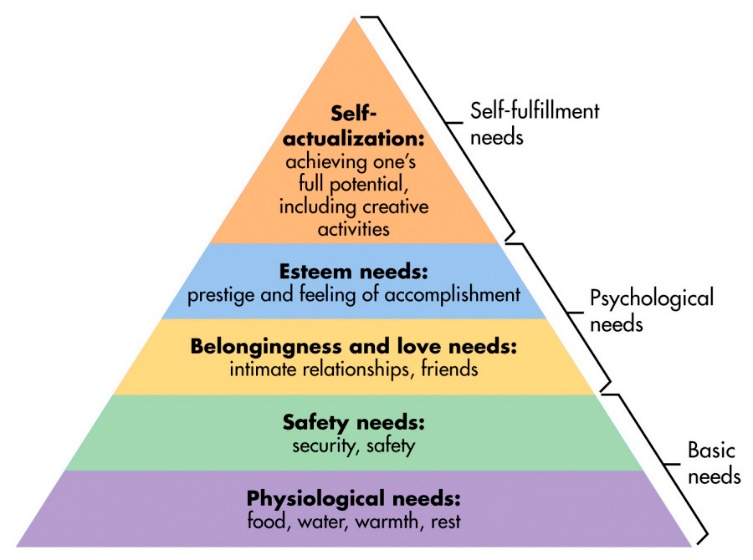
Maslow’s Hierarchy of Needs (source)
This five-stage model can be divided into deficiency needs and growth needs.
Each SkillGym character comes with two different layers of needs belonging to any of those levels according to the needs of the plot and of the situation.
This allows for our characters become real, bringing to the stage the same features as any human being:
- Their explicit needs, clear and evident needs that come out naturally during the conversation as the primary expression of the characters
- Their implicit needs, the subtler and not immediately shown impulses, that have to be discovered and considered by the user during the simulation to make sure that the conversation becomes truly fruitful
Each SkillGym character is a complex individual, making the experience of a conversation not just a mere exercise of techniques, but a deep dive into listening to other people to understand their hidden triggers, motivations and fears.
We believe this is the only way to go through a shallow relationship that regularly does not lead to results.
Training on SkillGym means developing the awareness of the other, which in turn, develops our own self-awareness.
Forging the personality of a Digital Role Play Character
To create realistic and reliable characters, each time we design the key tracts of their personality, we refer to well-established models that are widely accepted worldwide and that help to define the most important elements of how those character will behave and think.
We find it particularly useful to refer to widely accepted models, because they already have a wide application in different contexts and also are well-known and used for different purposes like assessment, analysis, change management, strategic decisions, etc.
The three models we normally refer to are the DISC, the HBDI (also known as Whole Brain) and the MBTI.
They vary in terms of purpose, angle of observation and meaning in what they try to describe.
This makes their integration even more interesting, because it is possible to take advantage of their differences synergistically.
We don’t intend to delve deep into each model in this article. If you would like to learn more about their backgrounds and details, the internet provides numerous sources of great information on these models.
At this juncture, we’d like to present how you can recognize some traits of each model in the psychometric structure of SkillGym characters.
The DISC model is a popular assessment tool that focuses on how people behave in a particular situation, and how they are perceived by others.
It’s a four-factor model in which the four dimensions are coded by a color and a letter: D for Dominance, I for Influence, S for Steadiness and C for Conscientiousness.
According to this model, a person is usually one-color-dominant and can be associated to mainly one of the four dimensions.
This chart clearly shows the model and its four profiles.
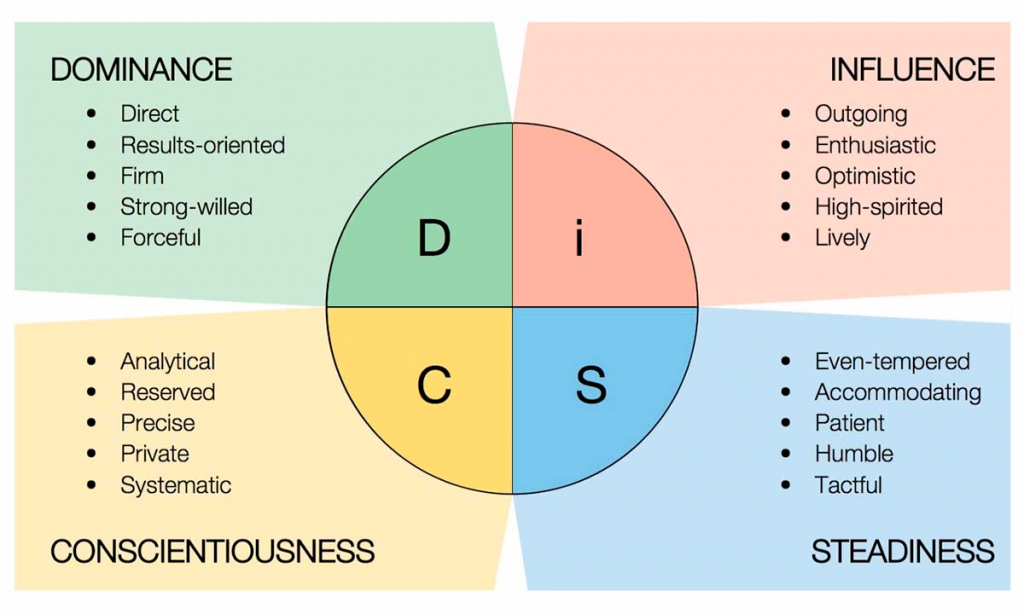
A schematic description of the DISC model (source)
The HBDI is based in the Whole Brain Thinking methodology, and it is another four-factor model.
Unlike the DISC that focuses on people’s behaviors, the HBDI focuses on how people process the information and on their thinking preferences.
That’s why people described with this model usually are not one-color defined, but they relate to more than one dimension, with different weights.
This chart shows the model and its four selves based on their thinking preferences.
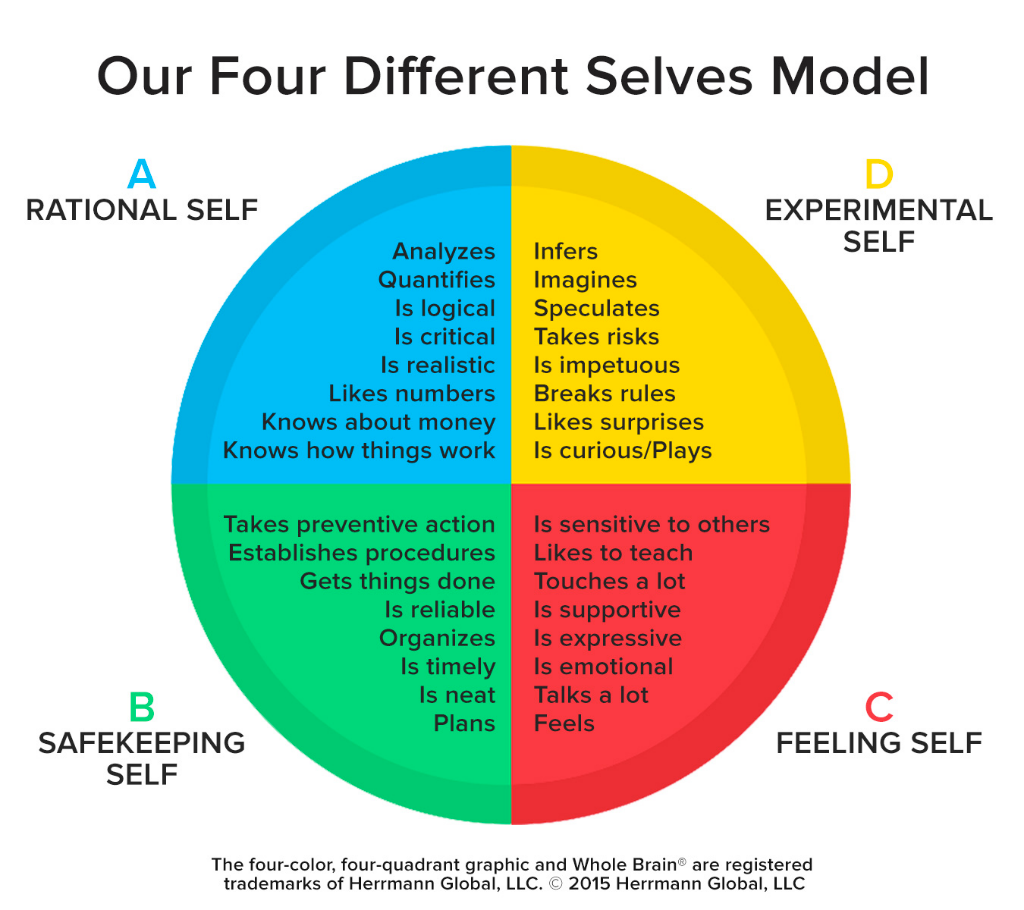
A schematic representation of the HBDI model (source)
The MBTI model (sometimes called 16-personalities) is based on the theory of psychological types described by C. G. Jung, and identifies 16 different personality types based on the differences in the ways people prefer to use their perception and judgment.
The combination of many factors determines the profile. In brief, here are the factors considered: favorite world (Extraversion or Introversion), information (Sensing or Intuition), decisions (Thinking or Feeling) and structure (Judging or Perceiving).
This chart shows all 16 personalities in what is called a “type table”.
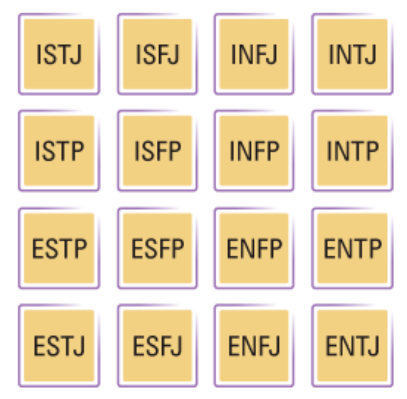
The 16 personality types listed in a “type table” (source)
SkillGym characters are inspired by well-known psychometric models that ensure that the Digital Role Play experience has the same learning value as a real one.
Like a real human being, each of our SkillGym’s characters behaves, thinks, sees the world, makes decisions and processes information in a distinctive way that can somehow be described consistently and according to the angles provided by the above models.
Without being the result of the mere application of each single model -SkillGym is NOT an exercise of style or the by-product of a modelized theory.
Each character becomes authentic and sustainable because it is the result of careful crafting around the most fundamental elements driving human beings.
This is the same that the most widely-accepted psychometric models and theories define and describe.
What about characters’ backgrounds?
Surely the personality of the character drives his behavior during the simulation, but also his previous history and background have a role in how he behaves in a conversation.
That’s why the complexity of a human-to-human conversation in our digital roleplay is also reflected in the availability of details given to the user before the meeting.
Thus, before starting, the user is encouraged to read the details about the character (including his social background, his personality and approach as well as his hierarchy of needs), where and why the conversation will take place (physical location, what role the trainee is going to play) and other details about the context (such as the scope of the conversation and any intermediate goals to be achieved).
This allows the learner to apply his skills and decide on a strategy just as he would normally do in real life.
Each situation, one style
When providing soft skills training, role play is one of the most effective strategies because it allows learners to practice a difficult conversation in a protected environment, while having the opportunity to discuss outcomes and receive personalized feedback.
In this context, the situation that is depicted in the simulator is very important and it is part of the training experience.
It’s within the situation that things, gestures, words and attitudes gain a meaning. Here we find it very useful to refer to the situational leadership theory, by which there is no single “best” style of leadership.
Effective leadership is task-relevant, and the most successful Leaders are those who adapt their leadership style to the performance readiness (ability and willingness) of the individual or group they are attempting to lead or influence.
Careful practice in the most common and the most critical situations that can happen in real life helps build confidence in the trainees and generate a “Deja-vu” effect in the most efficient way.
The dialogue between the user and the character of a SkillGym Digital Role Play takes place by selecting from a set of questions and answers that are designed to fit the most common communication styles and possible behaviors.
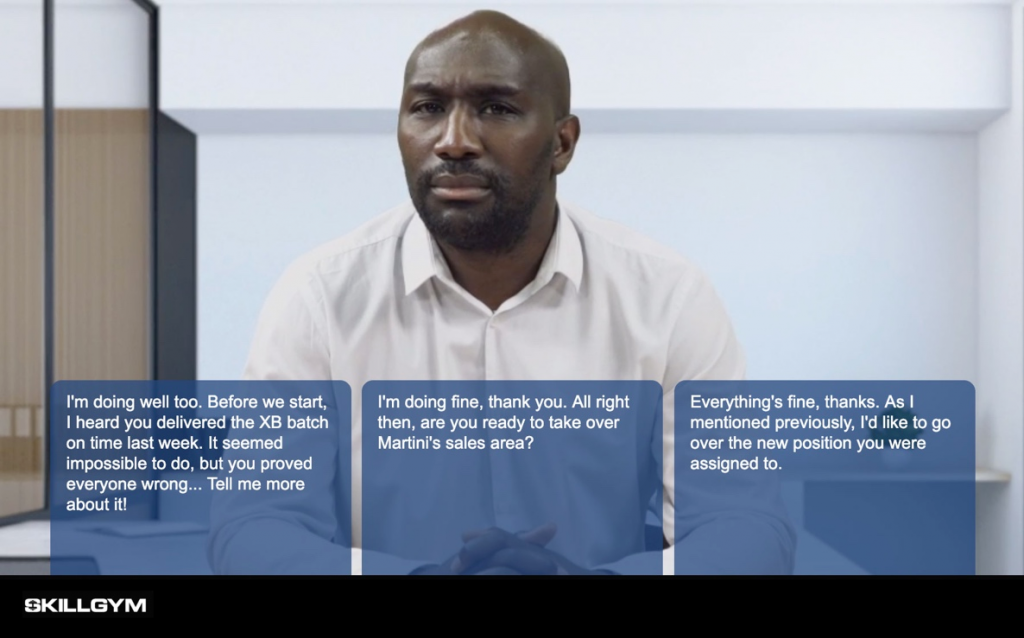
Each sentence represents one possible application of the requested skills and allows the conversation to flow according to one’s own style and topics.
If the user would not use any of the three sentences presented, he is encouraged to select the one he feels is the closest to his style.
In any case, the character will react according to a number of factors that are governed by SkillGym’s smart algorithm and consider all the elements, including the personality structure that builds up the specific character.
Thanks to SkillGym’s Augmented Replay, all the nuances of the character’s reactions and nonverbal communication can be reviewed in detail after the conversation has been played:
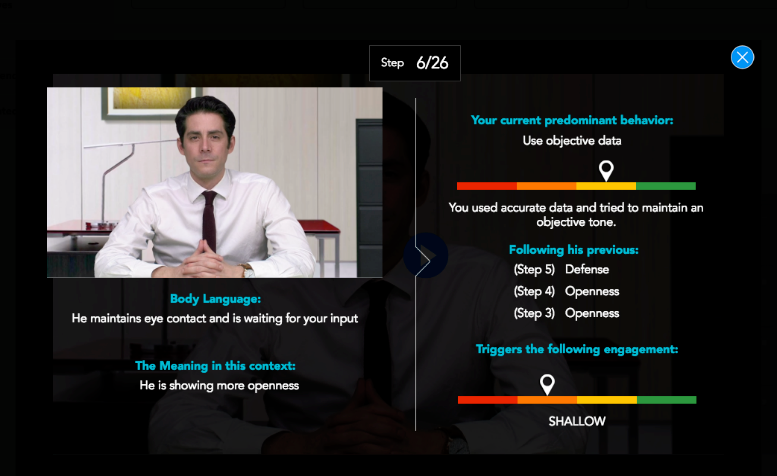
The “Augmented Replay” showing the body language of the character in details
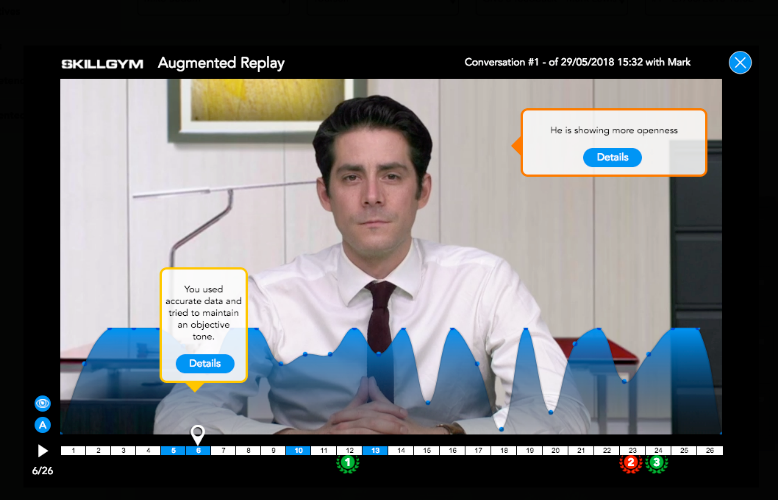
The “Augmented Replay” showing the mood of the character according to the reference model
The importance of theoretical foundations
Since the very beginning of our research on human behaviors and leadership styles, we were absolutely convinced of the importance of building Digital Role Play’s character on solid theoretical foundations.
And facts have shown that we were right.
In fact, each of us faces other people daily and each of them carries a very complex structure of personality and a mix of traits that contribute to the perception that we build about the others, even if most of us do not immediately recognize it.
Designing a training tool as delicate and complex as a Digital Role Play without considering those little, but so important nuances of human beings, would spoil the entire exercise and cut off all the value that human-to-human interaction can provide to self-growth.
For those of you who are interested in knowing more about how we bring together these fascinating behavioral concepts with the most advanced and cutting-edge technology, we have written a very interesting article (“How AI Helps Delivering a Better SkillGym Training Experience”) telling the story behind our AI algorithms.
More on the leadership style models that we consider when developing a Digital Role Play can be found in this article (“Digital Role Plays, the Best Way to Develop Conversational Leadership”).
Finally, to experience the result of this methodological and technological journey, the best thing to do is to book a 1-hour discovery call of SkillGym Digital Role Play.
